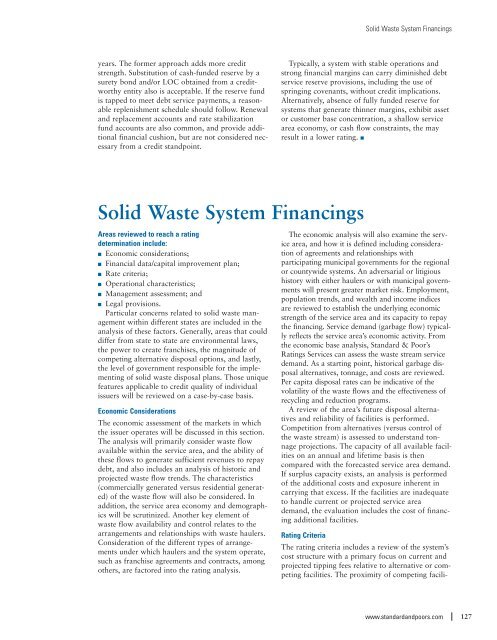S&P - Public Finance Criteria (2007). - The Global Clearinghouse
S&P - Public Finance Criteria (2007). - The Global Clearinghouse
S&P - Public Finance Criteria (2007). - The Global Clearinghouse
You also want an ePaper? Increase the reach of your titles
YUMPU automatically turns print PDFs into web optimized ePapers that Google loves.
Solid Waste System Financingsyears. <strong>The</strong> former approach adds more creditstrength. Substitution of cash-funded reserve by asurety bond and/or LOC obtained from a creditworthyentity also is acceptable. If the reserve fundis tapped to meet debt service payments, a reasonablereplenishment schedule should follow. Renewaland replacement accounts and rate stabilizationfund accounts are also common, and provide additionalfinancial cushion, but are not considered necessaryfrom a credit standpoint.Typically, a system with stable operations andstrong financial margins can carry diminished debtservice reserve provisions, including the use ofspringing covenants, without credit implications.Alternatively, absence of fully funded reserve forsystems that generate thinner margins, exhibit assetor customer base concentration, a shallow servicearea economy, or cash flow constraints, the mayresult in a lower rating. ■Solid Waste System FinancingsAreas reviewed to reach a ratingdetermination include:■ Economic considerations;■ Financial data/capital improvement plan;■ Rate criteria;■ Operational characteristics;■ Management assessment; and■ Legal provisions.Particular concerns related to solid waste managementwithin different states are included in theanalysis of these factors. Generally, areas that coulddiffer from state to state are environmental laws,the power to create franchises, the magnitude ofcompeting alternative disposal options, and lastly,the level of government responsible for the implementingof solid waste disposal plans. Those uniquefeatures applicable to credit quality of individualissuers will be reviewed on a case-by-case basis.Economic Considerations<strong>The</strong> economic assessment of the markets in whichthe issuer operates will be discussed in this section.<strong>The</strong> analysis will primarily consider waste flowavailable within the service area, and the ability ofthese flows to generate sufficient revenues to repaydebt, and also includes an analysis of historic andprojected waste flow trends. <strong>The</strong> characteristics(commercially generated versus residential generated)of the waste flow will also be considered. Inaddition, the service area economy and demographicswill be scrutinized. Another key element ofwaste flow availability and control relates to thearrangements and relationships with waste haulers.Consideration of the different types of arrangementsunder which haulers and the system operate,such as franchise agreements and contracts, amongothers, are factored into the rating analysis.<strong>The</strong> economic analysis will also examine the servicearea, and how it is defined including considerationof agreements and relationships withparticipating municipal governments for the regionalor countywide systems. An adversarial or litigioushistory with either haulers or with municipal governmentswill present greater market risk. Employment,population trends, and wealth and income indicesare reviewed to establish the underlying economicstrength of the service area and its capacity to repaythe financing. Service demand (garbage flow) typicallyreflects the service area’s economic activity. Fromthe economic base analysis, Standard & Poor’sRatings Services can assess the waste stream servicedemand. As a starting point, historical garbage disposalalternatives, tonnage, and costs are reviewed.Per capita disposal rates can be indicative of thevolatility of the waste flows and the effectiveness ofrecycling and reduction programs.A review of the area’s future disposal alternativesand reliability of facilities is performed.Competition from alternatives (versus control ofthe waste stream) is assessed to understand tonnageprojections. <strong>The</strong> capacity of all available facilitieson an annual and lifetime basis is thencompared with the forecasted service area demand.If surplus capacity exists, an analysis is performedof the additional costs and exposure inherent incarrying that excess. If the facilities are inadequateto handle current or projected service areademand, the evaluation includes the cost of financingadditional facilities.Rating <strong>Criteria</strong><strong>The</strong> rating criteria includes a review of the system’scost structure with a primary focus on current andprojected tipping fees relative to alternative or competingfacilities. <strong>The</strong> proximity of competing facili-www.standardandpoors.com127
















